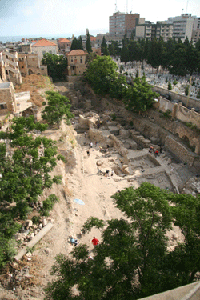For the first time, archaeologists are
revealing the 4,000-year history of one
of ancient Lebanon's oldest ports

Although the modern town of Sidon sits directly
on top of the ancient one, a multinational team has
been working for more than a decade to uncover the
many layers of the city's rich history. (Courtesy Mahan Kalpa Khalsa)
Wedged between a road and decaying
old houses perched on a hill,
sits a massive excavation site. A
century ago, this was the location of
an American school and, after that,
until a decade ago, was simply a
vacant lot. But Lebanese archaeologist Claude Doumet-Serhal
and her multinational team have transformed this apparently
unremarkable spot into a window on the rich ancient history
of the port city of Sidon. "In this little piece of land we have
everything, a slice of civilization," she says. "It's very exciting."
The reason for Doumet-Serhal's enthusiasm is easy to
see. In the shade of nearby bushes are piles of Roman bases,
columns, and capitals. Crumbling houses sit atop the remains
of a medieval wall within view of a ruined Crusader-era
castle. Just beyond lies another thirteenth-century castle,
overlooking the rocky shore of the Mediterranean Sea along
Lebanon's coast. Sidon is so old that, according to the Book
of Genesis, it was named after the great-grandson of Noah.
In antiquity, the city attracted an impressive array of visitors,
both welcome and unwelcome, including the first-century
B.C. king of Judea, Herod the Great; Jesus and St. Paul; the
armies of Alexander the Great in the fourth century B.C.; the
twelfth-century A.D. Norwegian king Sigurd; and the Mongols
of Central Asia a century later.

To read more, find ARCHAEOLOGY in your local newsstand or bookstore, or click here to buy a copy of the issue online. And if you'd like to receive ARCHAEOLOGY in your mailbox, click here to subscribe.
Andrew Lawler is a contributing editor at ARCHAEOLOGY.

